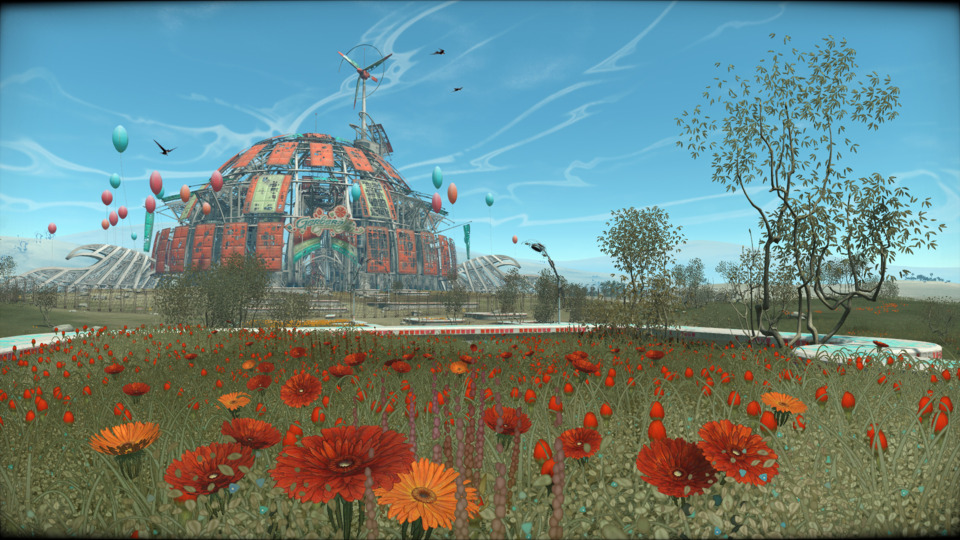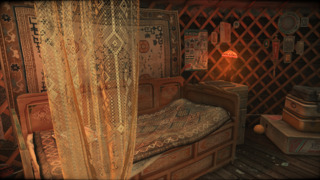
Cradle makes a hell of a first impression.
You wake up in a colorful room, dense with artifacts in a way that makes it feel lived-in, not just constructed for consumption. This small space and the things inside of it manage to communicate information about the world outside of its walls in both concrete and abstract ways. The room is covered from top to bottom with pamphlets, newspapers, advertisements, kitchen goods, consumer electronics, and other items for you to scour in search of answers about the place you've woken up in. But it also has objects that exist only to raise questions: Flowers numbered and pressed into hard plastic displays; a gynoid that doubles as a vase; a strange recipe that will eventually lead you to open the front the door.
Whenever I start a game as evocative as Cradle, I find myself thinking about a scene in Christopher Nolan's 2001 neo-noir Memento. The film follows Leonard, a man with a faulty memory, as he tries to piece together the facts of his fragmented life. Memento combines traditional mystery elements with a reversed scene structure as a way to communicate the protagonist's disoriented perspective. In the the scene that shoots into my mind, Leonard finds himself suddenly running through a trailer park. He looks around, takes stock of his surroundings, and says "Okay, what am I doing?" The audience is primed to ask its own questions: "Where is he going? Why run instead of walk? Who is that other guy sprinting through the--Oh!" Cradle's question is different ("Okay, what the hell is up with this world?"), but as in Memento, the game's player is slyly drawn into into asking questions of their own.
It's a technique that creates a great deal of potential, but it also means that the work needs to either answer the question (by providing a satisfying path to the answer) or else perform the rare feat of relieving the audience of their desire for an answer. Memento manages to do the former by echoing that scene's question throughout its entire runtime ("What is Leonard doing and what has he already done?"). Cradle, on the other hand, nearly succeeds at the latter. It lets some of the mysterious potential go to waste through an unfocused structure and a shift from self-directed investigation to linear exposition, but the world depicted is so fascinating that it's easy to forgive missteps and minor transgressions.
Without delving too much into the setting (since the most pleasurable part of the game is arriving at the specifics in your own time), Cradle is a game that explores themes of transhumanism, emotion, and the unexpected ramifications of scientific "progress." Despite this, it eschews the narrow alleys and overcrowded urban sprawl of our most familiar techno-dystopias, instead offering up the bright, broad, and painterly Eurasian Steppe of Mongolia. Yes, there are robots, laboratories, and mega-corporations enacting class warfare, but Cradle's take on cyberpunk is not the the smoke-and-neon standard that has become so familiar as to be defanged. The result is a science-fiction setting that is as striking as it is intriguing, and one that I almost sadistically wanted to remain in crisis, if only so that I might get to see another story told there.

You learn about Cradle's world and its inhabitants in a few different ways. At the start of the game, you make discoveries by carefully combing through all of the aforementioned ephemera spread throughout the starting room. Like Her Story, Gone Home, or Analogue: A Hate Story, this method of non-linear investigation allows players to stumble onto the larger picture from many different angles. This style of storytelling is fulfilling for me not only because it's (currently) so novel, but also because it so cleanly maps over my desire to answer the game's "central question."
Once Cradle introduces NPCs, though, it shifts into another, less satisfying modes of storytelling. In place of the organic detective work done in the game's first couple of chapters, the remainder delivers its story via dialogue. At first, I didn't mind this too much. The NPCs are themselves fascinating mysteries who know only bits and pieces about the world, and who say as much with their character designs as they do with their words. (Take, for instance, the way that Cradle's androids wear video-screens where their eyes should be, and that those screens actually display live action video of real, emotive human eyes.) But as the game continues on into its later chapters, these characters end up simply unspooling reams of lore in nearly one-sided conversations. It's a disappointing turn which misses the fact that the method of investigation is as important as the matter investigated.
This frustration is compounded by the fact that this exposition is locked up behind unnecessary navigation challenges and a recurring set of mini-games. While both feel tacked on, it's the latter that are truly out of place in an otherwise focused narrative adventure. In order to retrieve MacGuffins (which will in turn unlock more exposition), you need to attempt a sort of cube-collection action-puzzle game. I say "attempt" because after I completed the game I learned that failure at any of the later mini-games offers you the chance to simply move on with the story, but Cradle doesn't offer you this option ahead of time. Regardless, it's a jarring switch in gameplay that feels bolted on. While there is a fictionally coherent reason for these puzzles to be in the world, I couldn't quite shake the feeling that they were taking the place of investigation-style gameplay that would've been too expensive or time-consuming to implement. I don't know whether that feeling reflects the reality of Flying Cafe for Semianimals' production conditions, but I still couldn't shake that feeling that Cradle's ambitious narrative reach exceeded the practical grasp of its game design. Nowhere is this more apparent than in Cradle's final chapter, where climax deflates as quickly as it approaches.

As Cradle's credits sequence came to a close, I felt conflicted. Great premise, flawed execution. But Cradle didn't actually end at the credits for me. I did what I suspect many do after wrapping a game like this up: I turned to forums and to friends to compare theories. I read extra background information, filling in gaps of crucial story information I'd missed, as well as cultural knowledge I lacked. Cradle was made by a Ukrainian team on the western bounds of the same Eurasian Steppe that the game takes place in, and it leverages a number of conventions from Buddhism and other non-Abrahamic religions in ways that go beyond Western media's normal well of references to the East. As new distribution methods and more accessible technologies encourage greater exchange of games around the world, Cradle left me wondering how personal knowledge of cultural tropes may shape our play experiences. Case in point: The puzzle game that frustrated me and felt out of place actually integrates aspects of a particular Buddhist story. Might that knowledge have adjusted the way I felt about those puzzles when I first played them? The process of learning about the nuances I'd missed (both the cultural conventions and the narrative tidbits I'd overlooked) recreated the pleasure I had at the beginning of my playthrough. Cradle's protagonist had read page after page about the world he'd found himself in, and now I was doing the same.
For some, it might seem strange that I'd consider activity performed when Cradle's executable was closed to be "part of the game." But I don't think that this is actually unique to Cradle. My experience of Dark Souls has always been shaped by information-sharing with other players ("Oh! So that's what the "Adaptability" stat does!"). In poker, the best competitors do more than play the cards, they also "play" the other people at the table. Fez was completable only through information gathering and theorycrafting done by players "outside" of the game. Cradle follows in the footsteps of these games (and many others) by breaking down the binary between "inside" and "outside." This is only appropriate given the story's focus on disrupting and deconstructing our own notions about individual interiority and airtight selfhood.
Cradle isn't perfect. It doesn't fully follow through on the promised potential of the first few chapters. Its best ideas are stymied by inconsistent structure and poor pacing. Yet Cradle's unique setting, captivating characters, and fascinating mystery elevate it above its flaws, enshrining it as a new member in the ever-growing pantheon of great first-person narrative exploration games.
51 Comments